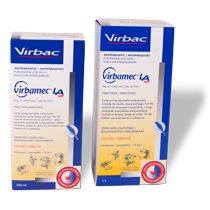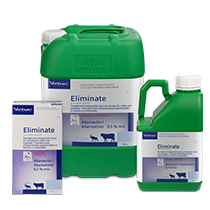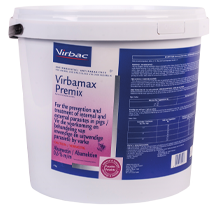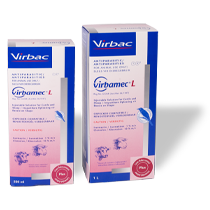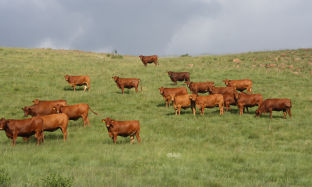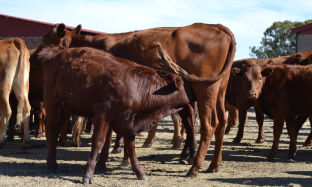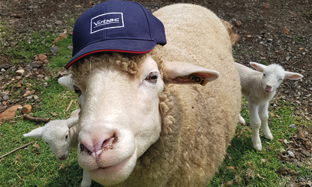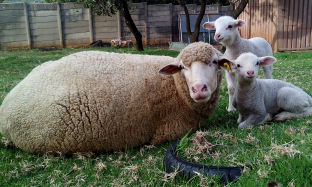
Worms
Virbamec® LA
Long-acting injectable antiparasitic remedy for cattle, sheep, pigs and ostriches.
FOR ANIMAL USE ONLY
CAUTION
CHEMICAL GROUP: ①†
† Macrocyclic Lactones
OXPECKER COMPATIBLE
COMPOSITION:
Ivermectin 1 % m/v
DIRECTIONS FOR USE: Use only as directed
Do not use intravenously.
Use of a 2,0 cm 16 gauge needle is recommended. The solution may be administered with any standard automatic or single-dose equipment.
Cattle: Inject subcutaneously or intramuscularly at 1 ml per 50 kg body mass. Inject subcutaneously under the loose skin in front of or behind the shoulder.
Appropriate vaccination precautions should be taken in areas where the risk of clostridial infections such as black quarter (sponssiekte) and malignant oedema are present.
Sheep: Inject subcutaneously only at 1 ml per 50 kg body mass. The loose skin of the sheep behind the shoulder is an acceptable site. Other administration sites are the skin under the foreleg (axilla) and the inside of the thigh. Ensure that the needle is carefully inserted and that the solution does not leak from the injection site. In wool sheep, ensure that the needle has penetrated the wool and skin before the dose is delivered.
Sheep scab: Sheep scab is a notifiable disease and treatment of suspected or confirmed outbreaks must be under government supervision. One treatment of Virbamec LA at a dose rate of 1 ml per 50 kg body mass by subcutaneous injection will eliminate the infestation. Ensure by proper management and supervision that all sheep on the farm are treated at the same time during an outbreak of sheep scab.
Sheep scab in Namibia: Even though this remedy is registered in South Africa for only one treatment, the law in Namibia states that two treatments, 7 – 10 days apart, are obligatory in the event of a sheep scab outbreak.
Pigs: Inject subcutaneously or intramuscularly at 1 ml per 33 kg body mass. Do not use intravenously.
Ostriches: Inject subcutaneously only. The recommended dose is 1 ml per 50 kg body mass for the control of ostrich wireworm (Libyostrongylus douglassii).
DOSAGE TABLE
|
Body mass (kg) |
Dose (ml) |
|
CATTLE |
CATTLE |
|
Up to 50 |
1 |
|
51 – 100 |
2 |
|
101 – 150 |
3 |
|
151 – 200 |
4 |
|
201 – 250 |
5 |
|
251 – 300 |
6 |
|
301 – 350 |
7 |
|
351 – 400 |
8 |
|
SHEEP |
SHEEP |
|
Up to 25 |
0,5 |
|
26 – 50 |
1,0 |
|
51 – 75 |
1,5 |
|
76 – 100 |
2,0 |
|
PIGS |
PIGS |
|
Up to 33 |
1 |
|
34 – 66 |
2 |
|
67 – 99 |
3 |
|
OSTRICHES |
OSTRICHES |
|
Up to 50 |
1 |
|
51 – 100 |
2 |
|
101 – 150 |
3 |
|
151 – 200 |
4 |
EFFICACY:
1. Internal Parasites
Cattle
|
Roundworms: |
Immatures |
Adult |
Persistency |
|
Wireworm (Haemonchus placei) including inhibited larvae |
* |
* |
35 days |
|
Brown Stomachworm (Ostertagia ostertagi) including inhibited larvae |
* |
* |
35 days |
|
Bankruptworm (Cooperia spp.) |
* |
* |
28 days |
|
Hookworm (Bunostomum phlebotomum) |
* |
* |
42 days |
|
Nodular worm (Oesophagostomum radiatum) |
* |
* |
49 days |
|
Lungworm (Dictyocaulus viviparus) |
* |
* |
21 days |
|
Eyeworm (Thelazia spp.) |
|
* |
|
|
Long-necked bankruptworm (Nematodirus spp.) |
|
* |
|
|
White bankruptworm (Strongyloides papillosus) |
|
* |
|
|
Ascarids (Toxocara vitulorum) |
|
* |
|
|
False bruising (Parafilaria bovicola) |
|
* |
|
Definition: * Control (≤90 % effective)
Sheep
|
Roundworms: |
Immatures |
Adult |
|
Wireworm (Haemonchus contortus) |
* |
* |
|
Nooitgedacht resistant wireworm strain (Haemonchus contortus) |
|
** |
|
Brown Stomachworm (Teladorsagia spp.) |
* |
* |
|
Bankruptworm (Cooperia spp.) |
* |
* |
|
Hookworm (Gaigeria pachyscelis) |
* |
* |
|
Nodular worm (Oesophagostomum spp.) |
* |
* |
|
Large-mouthed Bowelworm (Chabertia ovina) |
* |
* |
|
Lungworm (Dictyocaulus filaria) |
* |
* |
|
Long-necked bankruptworm (Nematodirus spp.) |
* |
* |
|
Whipworm (Trichuris spp.) |
|
* |
|
White bankruptworm (Strongyloides papillosus) |
* |
* |
Definition: * Control (≤ 90 % effective)
** Aids in control of (60 – 89 % effective)
Pigs
|
Roundworms: |
Immatures |
Adult |
|
Ascarids (Ascaris suum) |
* |
* |
|
White bankruptworm (Strongyloides ransoni) |
* |
* |
|
Nodular worm (Oesophagostomum spp.) |
* |
* |
|
Lungworm (Metastrongylus spp.) |
* |
* |
|
Whipworm (Trichuris spp.) |
|
* |
Definition: * Control (≤ 90 % effective)
Ostriches
|
Roundworms: |
Immatures |
Adult |
|
Ostrich wireworm including inhibited larval stages (Libyostrongylus douglassii) |
* |
* |
Definition: * Control (≤ 90 % effective)
2. External Parasites
Cattle
Virbamec LA kills:
Sucking lice (Linognathus vituli, Solenoptes capillatus, Haematopinus eurysternus);
Biting lice (Damalinia bovis);
Warble flies (Hypoderma bovis, H. lineatum);
Mange mite (Psoroptes bovis, Sarcoptes scabei var. bovis, Chorioptes bovis);
Sand tampans (Ornithodoros savignyi);
Cattle screw-worm (Chrysomya bezziana)
Blue tick (Boophilus spp.): Controls blue ticks for up to 42 days
Sheep
Virbamec LA kills:
Sheep scab mites (Psoroptes communis var ovis);
Sarcoptic mange mite (Sarcoptes scabei var ovis);
Australian itch mite (Psorergates ovis);
Sucking lice (Linognathus spp.)
Pigs
Virbamec LA kills:
Sucking lice (Haematopinus suis)
Mange mites (Sarcoptes scabei var. suis) with persistent activity for 56 days
3. Nasal worm (Oestrus ovis)
Sheep: Controls all stages (1st, 2nd and 3rd instar larvae)
WARNINGS:
- Cattle, sheep and pigs must not be slaughtered for human consumption within 42 days of last treatment.
- Ostriches must not be slaughtered for human consumption within 14 days of last treatment.
- Do not use in lactating cattle or sheep where milk or milk products are used for human consumption.
- Do not use in dairy cattle within 42 days before calving where milk and milk products are intended for human consumption.
- Do not administer intravenously in cattle, sheep and pigs. Do not administer intramuscularly in sheep.
- Ostriches to be injected subcutaneously only. Do not inject intravenously.
- Keep out of reach of children, uninformed persons and animals.
- Although this remedy has been extensively tested under a large variety of conditions, failure thereof may ensue as a result of a wide range of reasons. If this is suspected, seek veterinary advice and notify the registration holder.
PRECAUTIONS:
- Do not re-use empty bottles.
- Drug containers and any residual contents should be disposed of safely (e.g. by burying or incinerating), as free ivermectin may adversely affect fish and certain water-borne organisms.
- When ivermectin comes into contact with the soil, it readily and irreversibly binds to the soil and becomes inactive over time.
- Do not smoke, drink or eat while handling the product.
- Wash hands thoroughly after use.
- Use sterile equipment and follow aseptic procedures.
- Do not dilute or mix with any other substances.
- Vaccination of cattle against clostridial infections (eg. black quarter) is strongly recommended.
- Sheep should be vaccinated against pulpy kidney (enterotoxaemia) before treatment.
STORAGE INSTRUCTIONS:
Store at room temperature below 30°C. Protect from light.
PRESENTATION:
10 ml, 50 ml, 500 ml and 1 L polyethylene bottles
REGISTRATION HOLDER:
VIRBAC RSA (Pty) Ltd
(Reg. No. 1990/003743/07)
Private Bag X115
Halfway House
1685
South Africa
Tel: +27 12 657-6000
REGISTRATION NUMBERS:
South Africa Reg. No. G2885 (Act 36/1947)
Namibia Reg. No. V01/18.1.2/109 NS0

